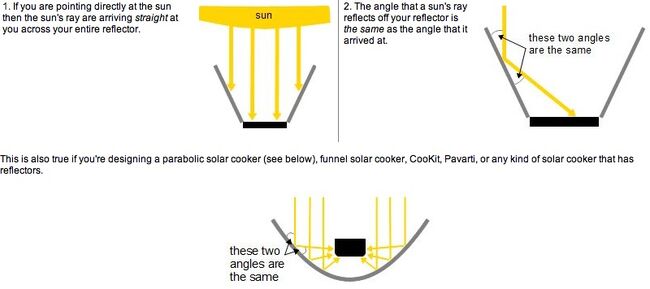Basic reflector theory
The orientation and shape of reflectors that focus light on the cooking pot can often be calculated using some fairly simple geometry. Basically, the light from the sun will be coming to the solar cooker in parallel rays. Light will hit the reflector at a particular angle, and then bounce off towards the cook pot at the same angle. The theory is the same for box, panel, or parabolic solar cookers. The idea is illustrated below:
A helpful rule of thumb, shown below, that works for many designs is that the only sun's ray you need to worry about is the one that reflects off the top of your reflector. All sun's rays that reflect lower down will hit your target surface somewhere as long as the top ray hits your target on the opposite side.
Using multiple reflector angles
Solar box oven cookers cannot always be tilted to face the sun if the sun is low in the sky. Doing so may cause the cooking pot to tip over, or if the pot is on a swivel base, it may already be at it's maximum swivel angle.
To handle this situation you'd tilt the oven as much as you can. Then, as shown in the following diagram, you'd put the top reflector on a very steep angle and the bottom reflector on a very shallow angle. Note that the angles are adjusted below such that the angles that the sun's rays reflect off the reflectors are the same as the angles that the sun's rays arrived at the reflectors. This is just as is decribed at the very top above as the number 2 thing to know.
Improving the sunlight capture area
The capture area is basically the amount of sunlight you're capturing and then concentrating using the reflectors. It's basically the size of the hole made by the top of the reflectors.
So does simply making the reflectors longer while keeping the angle the same as shown in the following diagram improve the capture area? The answer is no, since the sun's rays that strike the top of the reflector will eventually reflect back out without hitting the target area and the cooking pot in a solar cooking oven in this example. Read more about sunlight capture at: Sunlight capture area - rimstar.org
This article has explained the basic theory of configuring reflectors for solar cookers. To learn more, see the entire article this information is taken from: How to design solar reflectors for solar cookers - rimstar.org




